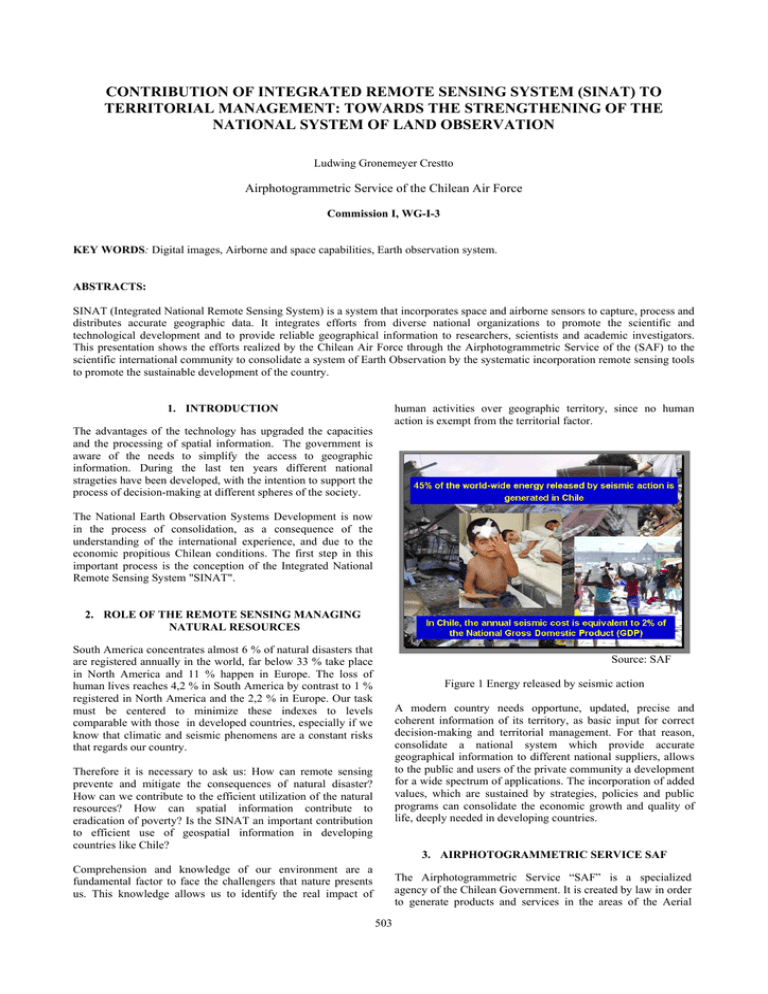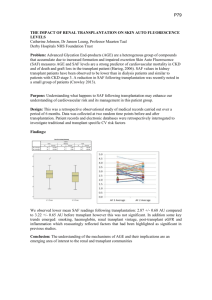CONTRIBUTION OF INTEGRATED REMOTE SENSING SYSTEM (SINAT) TO
advertisement

CONTRIBUTION OF INTEGRATED REMOTE SENSING SYSTEM (SINAT) TO TERRITORIAL MANAGEMENT: TOWARDS THE STRENGTHENING OF THE NATIONAL SYSTEM OF LAND OBSERVATION Ludwing Gronemeyer Crestto Airphotogrammetric Service of the Chilean Air Force Commission I, WG-I-3 KEY WORDS: Digital images, Airborne and space capabilities, Earth observation system. ABSTRACTS: SINAT (Integrated National Remote Sensing System) is a system that incorporates space and airborne sensors to capture, process and distributes accurate geographic data. It integrates efforts from diverse national organizations to promote the scientific and technological development and to provide reliable geographical information to researchers, scientists and academic investigators. This presentation shows the efforts realized by the Chilean Air Force through the Airphotogrammetric Service of the (SAF) to the scientific international community to consolidate a system of Earth Observation by the systematic incorporation remote sensing tools to promote the sustainable development of the country. human activities over geographic territory, since no human action is exempt from the territorial factor. 1. INTRODUCTION The advantages of the technology has upgraded the capacities and the processing of spatial information. The government is aware of the needs to simplify the access to geographic information. During the last ten years different national strageties have been developed, with the intention to support the process of decision-making at different spheres of the society. The National Earth Observation Systems Development is now in the process of consolidation, as a consequence of the understanding of the international experience, and due to the economic propitious Chilean conditions. The first step in this important process is the conception of the Integrated National Remote Sensing System "SINAT". 2. ROLE OF THE REMOTE SENSING MANAGING NATURAL RESOURCES South America concentrates almost 6 % of natural disasters that are registered annually in the world, far below 33 % take place in North America and 11 % happen in Europe. The loss of human lives reaches 4,2 % in South America by contrast to 1 % registered in North America and the 2,2 % in Europe. Our task must be centered to minimize these indexes to levels comparable with those in developed countries, especially if we know that climatic and seismic phenomens are a constant risks that regards our country. Source: SAF Figure 1 Energy released by seismic action A modern country needs opportune, updated, precise and coherent information of its territory, as basic input for correct decision-making and territorial management. For that reason, consolidate a national system which provide accurate geographical information to different national suppliers, allows to the public and users of the private community a development for a wide spectrum of applications. The incorporation of added values, which are sustained by strategies, policies and public programs can consolidate the economic growth and quality of life, deeply needed in developing countries. Therefore it is necessary to ask us: How can remote sensing prevente and mitigate the consequences of natural disaster? How can we contribute to the efficient utilization of the natural resources? How can spatial information contribute to eradication of poverty? Is the SINAT an important contribution to efficient use of geospatial information in developing countries like Chile? 3. AIRPHOTOGRAMMETRIC SERVICE SAF Comprehension and knowledge of our environment are a fundamental factor to face the challengers that nature presents us. This knowledge allows us to identify the real impact of The Airphotogrammetric Service “SAF” is a specialized agency of the Chilean Government. It is created by law in order to generate products and services in the areas of the Aerial 503 The International Archives of the Photogrammetry, Remote Sensing and Spatial Information Sciences. Vol. XXXVII. Part B1. Beijing 2008 Photogrammetry and Remote Sensing. Its aims and objetives are quality, profesionalism, and constant support of the national development as well as providig vital information for accurated decision-making in which chilean actors can supportt a sustainable national improvement, to create and deliver tools of analysis in the field of earth science, and produce aeronautical chart to suport a aviation safety. All this ideas are contained in the law Nº 15.284 of 1963. autonomy, and the capacities to obtained and managed of geoespacial information of Chilean territory. Shaped by a Terrestrial Segment, an Airborne Segment and a Spatial Segment, the SINAT will allow to cover the Chilean geoespacial information requirements in complete form. Constructed, grouping in its interior the current capacities and the new resources, which include different airborne sensors and technological capacities. The SINAT will let establish a formal and updated National Geographical Information Database (BDNIG), available for different organizations and national institutions that need reliable territorial information. And constitute a national validated source of geoespacial information with the intention of supporting the national development and optimizing the employment of the natural and cultural resources. The SAF is responsible of capture, generate and distribute Aerialphotogrammetric surveys, Aeronautical Charts, Satellite Images and others cartographic products. Its principal roll is to deliver, to the users' community, reliable and opportune geographical information. The SAF staff has vast knowledge and experience in the photogrammetric industry. They provide a personalized and technical expertise to produce quality geographical products. During the year 2005, the SAF has obtained the ISO 9001:2000, certification. Now it is developping a quality evaluation system that provides a framework for determining and evaluating quality control applicable to digital geographic datasets, consistent with standard defined in ISO/TC 211 (19113 – 19114 - 19115). It has also established metada software for reporting data quality results. 4. GEOGRAPHICAL INFORMATION AND DECISION MAKING Because of the economic development that Chile has been experienced during the last decade, it needs an correct knowledge of geoespaciales phenomena and its interrelationships, in order to support a suitable decisions taking. Source: SAF Figure 2 Integrated National Remote Sensing System The joint of the different national actors linked to the generation, transmission and employment of geographic information, which at this moment work independent from each others, help to insure an appropriated use of national economic resources. The suitable integration of different Territorial Observation Centers (public and private, civil and military, national and international), as well as unification with primary, intermediate and final users, will allow a wide range of researches in the areas of; Climate, Health, Disasters, Ecosystems, Biodiversity, Energy, Defense, Education, Agricultural and Forest. Under this context the integration of organisms and capacities increase the social well. Technological resources management, it is one of the key areas to reach results on a global and competitive market. Different research show that after a few years, the professionals of different areas experience the imperious need to renew his technical and scientific knowledge, with the intention of not becoming obsolescence. Then, the incorporation of new geospatials tools appears as a priority, particularly in the developing countries, where the natural resources play an important social role, since the possibilities of spatial analysis helps the governments in the decisions-making. So, any activity has a spatial expression, every element, phenomenon or action that the man executes on the surface of the Earth, has spatial and temporary components, this allows to interrelate differently actions, in order to make concrete solutions in benefit of the men and the community in general. SINAT answers current and future needs, delivering integrated solution to regional and national needs increasing social benefits significantly, across a constant improvement of human health conditions, rational resources exploitation and economic growth. This presentation is oriented to present the different capacities of SINAT’s system, serve has guide and aid other countries to develop its own proper solutions, helping out to have a population, an economy and a healthy planet. 5. VISION The Chilean Air Force, particularly the Airphotogrammetric Service (SAF), has developed a system named Integrated National Remote Sensing System (SINAT), with the mission to capture process and share geospatial information, incorporating new technical and human capacities. 6. SAF INVESTMENTS PROGRAM The SAF Investment program objekt, is orientated to shape Integrated National Remote Sensing System, which provides to the Chilean State an autonomous way in the capacities of apprehension and management of geoespacial information. This SINAT answered the need to integrate and develop new capacities of apprehension territorial information in digital format, in replacement of the traditional way. SINAT was projected as a technological climbing, which link different national efforts providing at the State of Chile the tools, the 504 The International Archives of the Photogrammetry, Remote Sensing and Spatial Information Sciences. Vol. XXXVII. Part B1. Beijing 2008 The SINAT solution consist in a sistematical incorporation of satelite and aereial digital sensor. 8. DIGITAL AERIAL SENSORS The replace SAF aerial film cameras stated with the idea of producing a much higher level of automation in photogrammetric data capture and process. The program general design, considers a airborne digital sensor gradual acquisition, such as a Multispectral Camera, Hyperspectral Sensor, Laser Sensor and other airborne digital sensors. As well as incorporate the capability of storage, administration and processing of the great quantity of digital information that are captured by these means. The project among other aspects, will generate the following benefits: • Optimize the employment of the natural resources. • Promote the territorial management . • Support the generation and application of public policies in different national areas. • Prevention of natural risks. • Strengthen the development of the extreme zones of the country. • Standardization of territorial digital information. • Improve the access at the geographical information. 7. SATELLITE GROUND STATION Figure 4 Integrated Capacities Source: SAF Recently, in April 2008, SAF has installed a Satellite Ground Station, in order to plan and capture satellite images from high spatial and spectral resolution satellites. Those capabilities, place SAF as a national leader in Remote Sensing. 9. APPLICATIONS CAPABILITIES In almost three decades the remote sensors on board of planes and satellites, have been in use as source of information for studies of natural resources, due to advantages that they present such as: global coverage, repetitivity and exhaustive scrutiny of the terrestrial surface, panoramic perspective, spatial observation multiclimbs, information about not visible regions of the electromagnetic spectrum and immediate transmission in digital format, between others. The Ground Station Antenna is installed, in SAF facilities, at the Santiago International Airport. The SAF Ground Station is providing the capacity to receive the data from high resolution satellites, multiespectral and hyperespectral satellites covering Chilean territory. There are separate Command and Data Acquisition area, providing the capability for monitoring and control a commercial satellites constellation. In addition the data are transmitted from the ground station to the SAF Production Area for processing, archiving and further distribution to users. Communication from the Ground Station to the Production Site is via a fibre optic link. The ground station system provides the capability to capture geographical data and process them. Our country has not been absent in the use of this technology accordin to its own possibilities as development nation. Diferent types of applications have been realized in agricultural and forest cadasters; precision agriculture; mining explorations; fisheries; water resources; cartography; planning to regional and communal levels; besides studies of the environment, natural disasters and in several other areas using analogous existing technologies. These brought technological lack with the developed countries, that demonstrated that the access to the technology allows increase quantitative the national development. 10. CONTRIBUICION EARTH OBSERVATION SYSTEM The technological advances in the aspects of standardization, normalization, channels of distribution and access to the information they have been slow, if we compared with the advances obtained in the field of the computer science. In this respect, has been observed that the producers of the information; in many cases they do not have them well documented or the don’t know its real characteristics and even, do not know the update and validity of same ones. Also, it is frequent to find problems of access for an excess of zeal or for a lack of control. Figure 3 SAF Ground System Antenna Source: SAF SINAT will support the design of standards with the intention of defining policies, standards, of developing Spatial Data 505 The International Archives of the Photogrammetry, Remote Sensing and Spatial Information Sciences. Vol. XXXVII. Part B1. Beijing 2008 Infrastructure, Management. Earth Observation Systems and Land 11. CONCLUSIONS The economic development of a country needs of a suitable territorial management, based on the knolowge of a complex relations between economic, social factors, that happen over a geografical area. For that reason gobenrament needs geoespacial information reliable and opportune. The relevant and innovative of the project "SINAT", corresponds to the development and application of a technology with strong digital component, which allows a constant check of the state) of the geoespatial information, giving integrity and relevancy to the information. ACKNOWLEDGE Departamento Geografico – Sbdirección - SAF 506




